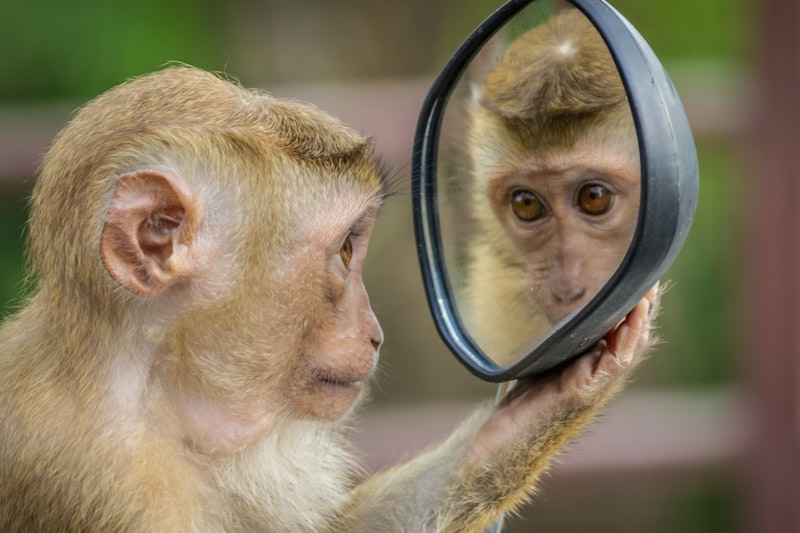Have you ever wondered how primates, our closest relatives in the animal kingdom, behave in their natural habitats? The behavioral ecology of primates offers a fascinating glimpse into their social dynamics, foraging patterns, and adaptations to their environments.
Primates, including apes, monkeys, and lemurs, exhibit a wide range of behaviors that are influenced by their ecological surroundings. One key aspect of their behavior is social structure. For instance, chimpanzees live in communities led by alpha males, where complex social hierarchies govern interactions. In contrast, spider monkeys are known for their more fluid social groups, often forming associations based on mutual benefits such as protection and foraging efficiency.
Understanding the foraging behavior of primates provides insights into their dietary preferences and how they obtain food resources. Different species have evolved various strategies: some are predominantly herbivorous, consuming leaves and fruits, while others supplement their diet with insects or even hunt small animals. This diversity reflects the adaptability of primates to different ecological niches and food availability in their habitats.
Moreover, the study of primate communication reveals intricate systems of signals and calls that facilitate social cohesion and reproductive success. From the booming calls of howler monkeys echoing through rainforests to the silent gestures exchanged by bonobos, communication plays a vital role in maintaining group cohesion and avoiding conflicts.
Ecological factors such as habitat loss and climate change pose significant challenges to the behavioral ecology of primates today. As their natural habitats shrink, primates must adapt to new environments or face the risk of extinction. Conservation efforts thus play a crucial role in preserving not only the species but also the complex behaviors that define their ecological roles.
In summary, the behavioral ecology of primates offers a rich tapestry of insights into their social interactions, foraging behaviors, and adaptive strategies. By studying these aspects, researchers can better understand our evolutionary past and contribute to the conservation of these intelligent and charismatic animals.
Decoding Social Dynamics: How Primates Form Hierarchies in the Wild
Have you ever wondered how social structures evolve among primates in the wild? Let’s delve into the fascinating world of social dynamics and hierarchies among these intelligent creatures.
In the heart of lush rainforests and vast savannas, primates such as chimpanzees, gorillas, and baboons display intricate social behaviors that mirror our own societal structures. At the core of their social framework lies the formation of hierarchies, a system where individuals rank higher or lower based on various factors like strength, intelligence, and social skills.
Picture a troop of chimpanzees navigating through dense foliage. They exhibit a dynamic social order where dominant individuals assert authority through displays of power and aggression. These alpha members often control access to food, mates, and territory, ensuring their position at the top of the hierarchy.
Interestingly, hierarchy isn’t solely about physical prowess. Social intelligence plays a crucial role. Primates engage in complex social interactions involving grooming, sharing food, and forming alliances. These interactions strengthen bonds within the group and influence hierarchical standings. Just like in human societies, strategic relationships can elevate an individual’s status and influence.
For instance, in baboon troops, females often inherit their social rank from their mothers. This maternal lineage shapes their position within the troop, affecting their access to resources and protection. It’s a delicate balance of power and cooperation that ensures the troop’s survival in challenging environments.
Observing these behaviors sheds light on our own evolutionary history. We share common ancestry with these primates, and studying their social dynamics provides insights into how our own social structures may have evolved over millennia.

Next time you observe a group of primates in a documentary or at a zoo, consider the intricate web of relationships and hierarchies at play. From leadership struggles to alliances forged in adversity, their social world is both captivating and enlightening, offering a glimpse into the complexities of social behavior in the animal kingdom.
Insights into Primate Communication: Unraveling the Role of Gestures and Calls
Gestures play a pivotal role in primate communication. From subtle movements to elaborate displays, gestures convey a range of messages. For instance, a chimpanzee might extend its hand as a sign of greeting or offer a reassuring pat on another’s back during moments of distress. These gestures aren’t merely instinctual; they often carry nuanced meanings that help maintain social harmony within primate groups.
Equally important are primate calls, which serve as vocal expressions integral to their communication repertoire. Each species exhibits distinct vocalizations that serve various purposes. For example, the piercing alarm calls of vervet monkeys warn of predators nearby, triggering coordinated responses from the group to evade danger swiftly. Meanwhile, the rhythmic hoots and grunts among gibbons establish territory boundaries and reinforce pair bonds.
What makes primate communication truly remarkable is its adaptability and context sensitivity. Primates adjust their gestures and calls based on the situation, demonstrating a level of cognitive flexibility akin to our own. Whether it’s negotiating conflicts, expressing affection, or coordinating group activities such as foraging or grooming, these communicative strategies are essential for their survival and social cohesion.
Moreover, studying primate communication offers insights into our own evolutionary history. The similarities in gestures and vocalizations between primates and humans hint at shared ancestry and provide clues about the origins of language and social behavior in our species.
Survival Strategies: Examining Food Foraging Techniques Among Primate Species
Food foraging among primate species showcases incredible adaptability and intelligence in their survival strategies. Primates, ranging from chimpanzees to lemurs, employ various techniques to secure food sources in their natural habitats.
One of the most fascinating aspects of primate foraging is their ability to utilize tools. For instance, chimpanzees in West Africa have been observed using stones to crack open nuts, displaying a level of cognitive sophistication akin to early human tool use. This behavior not only highlights their problem-solving skills but also underscores their ability to adapt to different ecological niches.
Moreover, the diversity in foraging techniques extends beyond tool usage. Gorillas, for example, are predominantly herbivorous and exhibit complex social behaviors during feeding, often foraging together in groups. This communal approach not only helps in securing food but also strengthens social bonds within the group.

In contrast, smaller primates like capuchin monkeys demonstrate remarkable agility and dexterity when foraging for fruits and insects in tree canopies. Their nimble fingers and sharp eyesight enable them to extract food from hard-to-reach places, showcasing a specialized adaptation to their arboreal lifestyle.
Additionally, the foraging strategies of primates are not just about acquiring sustenance but also about minimizing risks. Baboons, known for their opportunistic feeding habits, exhibit vigilance and group coordination to detect predators while searching for food on the savannah. This cautious behavior reflects their evolutionary adaptation to a more open and dangerous environment.
Overall, the study of food foraging among primates reveals a nuanced interplay between ecological pressures and behavioral flexibility. By investigating these strategies, researchers gain insights into the evolutionary pathways that have shaped primate cognition and social dynamics over millions of years.
This article aims to capture the engaging aspects of primate behavior in foraging, employing a conversational tone and focusing on key evolutionary adaptations and survival strategies.
From Play to Bonding: The Importance of Social Play in Primate Communities
Imagine a group of young chimpanzees swinging from branch to branch, engaging in mock battles and playful chases. This behavior isn’t just fun and games; it’s a crucial part of their social education. Through play, young primates learn valuable skills such as communication, cooperation, and conflict resolution. These skills are essential for their survival and integration into the complex social fabric of their communities.
Social play also strengthens social bonds among group members. Just like humans bonding over shared activities, primates build relationships through play sessions. These interactions foster trust and camaraderie, which are essential for maintaining group cohesion and cooperation. In some primate species, such as bonobos, play serves as a tool for reducing tension and resolving conflicts within the group.
Moreover, social play is a platform for learning social roles and hierarchies. Young primates often mimic adult behaviors during play, which helps them understand their place within the group dynamics. It’s akin to human children playing “house” or “school,” where they experiment with different roles and social scenarios.
Interestingly, social play isn’t limited to juveniles. Adult primates, too, engage in play behaviors, albeit less frequently and with different objectives. For adults, play serves as a means of reinforcing social bonds, reducing stress, and maintaining cognitive sharpness.
In summary, social play in primate communities isn’t just a display of agility and joy; it’s a sophisticated social tool with profound implications for group cohesion, individual development, and community dynamics. By observing and participating in play, primates learn the skills needed to navigate their social world, ensuring their place within the intricate tapestry of their community’s life.
Frequently Asked Questions
What role does mating behavior play in primate social dynamics?
Learn how mating behavior influences primate social dynamics, shaping group structure, hierarchy, and reproductive success. Explore its impact on social bonds, conflict resolution, and the transmission of cultural behaviors within primate communities.
How do primates select and defend their habitats?
Learn how primates choose and protect their habitats. Explore factors influencing habitat selection, such as food availability and safety. Discover how primates defend territories through vocalizations, displays, and group cooperation.
What is behavioral ecology and how does it apply to primates?
Learn about behavioral ecology in relation to primates, exploring how this field studies their social interactions, mating behaviors, and adaptation strategies. Understand the application of behavioral ecology to primates, focusing on insights into their evolutionary traits, ecological roles, and conservation implications.
What factors influence the feeding behavior of primates?
Learn about the factors that impact the feeding behavior of primates, including dietary preferences, habitat availability, social structure, and evolutionary adaptations. Explore how these factors shape primate feeding strategies and survival in their natural environments.
How do primates communicate within their social groups?
Learn how primates communicate within their social groups, including gestures, vocalizations, and facial expressions used for conveying emotions, warnings, and establishing hierarchies.


